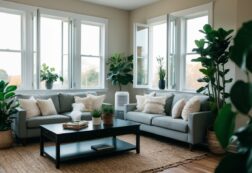
Enhancing your home’s curb appeal often involves paying attention to small details. One overlooked aspect is choosing exterior doors that blend with your architectural style. Whether your home is a Colonial, Craftsman, Contemporary, or another style, the right doors can elevate its appearance. For those seeking a tailored touch, OEM Fabricated Parts for Retail Displays can inspire creative solutions, offering customizable elements to match your unique design preferences.
But with so many options on the market, from materials to colors to door types, how do you select an exterior door that blends with and complements your existing motif?
As you remodel or upgrade the doors on your house, consider these recommendations to create a cohesive, harmonious, and visually appealing look that boosts curb appeal. Enhance your home’s aesthetics and seamlessly blend indoor and outdoor spaces with elegant glass patio doors.
Identify Your Home’s Architectural Style
Start by doing an online search for architectural styles that match your home’s main features. Key indicators to note are the window shapes and trim work styles. Take photos of your home from multiple angles to catalog all exterior details.
Moreover, look for columns, moldings, entryway designs, and other features to determine if your home is Craftsman, Victorian, Colonial, etc. Also, make a note of the predominant building materials and color scheme.
Getting an objective assessment through research can help you define whether your home aligns with a particular style. Attention to these architectural details is crucial for choosing doors that enhance your aesthetic preference.
Research Door Styles Suited To Your Home’s Architecture
Apart from identifying your home’s architectural style, determine the size, style, and type of door suited for your space. For example, if you have a large space, you can opt for doors that are flexible enough to be opened in wide spaces, like Bi fold doors.
Also, when researching door options, consider what materials dominate your home’s construction. Wood doors often complement Craftsman, Colonial, and cottage styles featuring natural materials. Meanwhile, metal or fiberglass choices tend to suit Modern architecture with clean lines.

Use your architectural research to inform material durability needs, too. Consider environmental factors like intense sunlight exposure, prevailing winds or rains, and typical wear and tear. Aesthetics matter less if replacement is frequent, so assessing viability for your region should help determine ideal door style discoveries.
Narrow Down Door Types
When selecting new doors, carefully weigh the pros and cons of materials like wood, steel, and fiberglass for exterior and interior doors. Fiberglass is often a top choice for exterior, given its durability, low maintenance, and energy efficiency. On the other hand, steel doors are also weather-resistant, though less aesthetically pleasing.
For interiors, hollow core doors are affordable but lightweight, while solid wood provides attractive substance. You can also explore fiberglass interior doors for a durable middle-ground option.
As you rank your top 1-2 picks for exterior and interior doors, consider factors like budget, visual appeal, insulation needs, and noise-blocking properties of each material. By narrowing preferences early, you can streamline decision-making on door styles and finishes.
Compare Door Samples
When choosing new doors for your home, order free small samples from manufacturers of your top choices to examine the exact materials and finish. Inspect the quality of construction, weathering textures, glossiness, and undertones.

Doors impact spaces daily, so evaluating how tones, grains, and textures make you feel through samples that realistically indicate upgrades is important. Allow ample time to envision your home’s flow with significant-finish decisions thoughtfully.
Measure Door Openings
Carefully measure inside each existing door jamb and frame opening using a tape measure. Note if the spacing is a standard width or depth, irregular, or angled. Also, measure the overall depth of each entryway.
Then, sketch a diagram of each installation area with all measurements marked, including details like baseboards or floor-level transitions. Having accurate opening dimensions is crucial for buying replacement doors that will properly fit.
Benefits of Having Doors that Matches Your Home’s Architecture
Here are some of the top benefits of having a door that matches your home’s architecture:
- Enhanced Curb Appeal: A door that seamlessly blends with your home’s existing architectural style instantly elevates the exterior aesthetic. It pulls the look together into one cohesive and stylish exterior that impresses.
- Added Character: Doors that match the era and style of your house add more authentic depth and personality. The details on a Craftsman door for a Craftsman bungalow, for example, uniquely showcase the home’s background.
- Energy Efficiency: Replacing dated doors with new ones catered to your motif often provides better insulation and draft protection. This saves substantially on heating and cooling bills.
- Noise Reduction: Specialized exterior doors with modern assemblies, sweeps, seals, and insulating glass help better barricade outside noise pollution.
- Security Reinforcements: Architecturally appropriate doors designed for the spacing of your home can include reinforced strike plates, security hinges, and shatter-resistant glass for forcing resistance.
- Interior Harmony: Interior doors mimicking the architectural style promote an inviting flow between living spaces. They blend rooms beautifully.
Conclusion
Choosing new doors suited to your home’s architectural genre takes research, precise sizing, and sample comparisons. But the effort pays off in enhanced curb appeal, energy savings, noise reduction, and an authentic refresh. With some strategic searching and planning, you can install new doors that blend seamlessly to play up your home’s best qualities.












